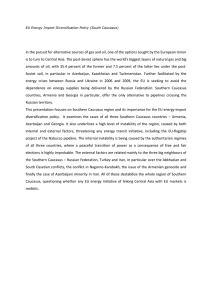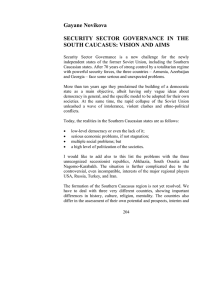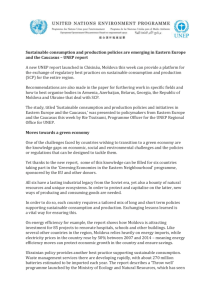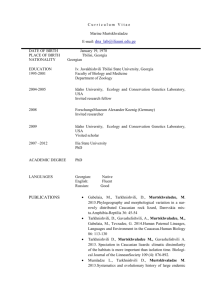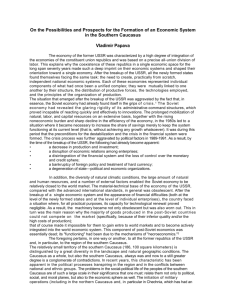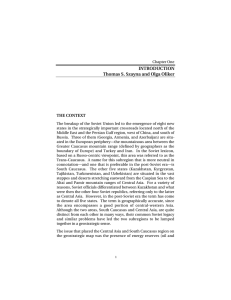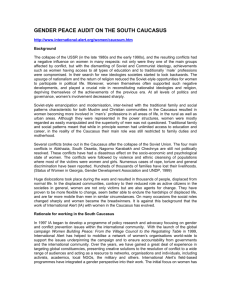China in the South Caucasus
advertisement
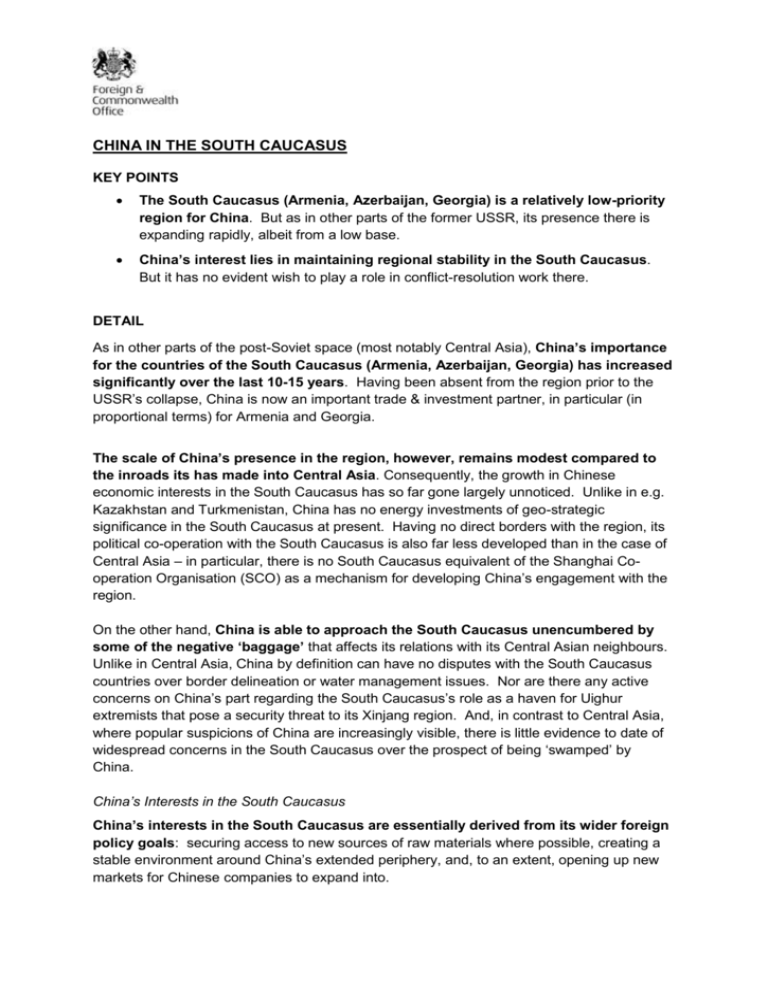
CHINA IN THE SOUTH CAUCASUS KEY POINTS The South Caucasus (Armenia, Azerbaijan, Georgia) is a relatively low-priority region for China. But as in other parts of the former USSR, its presence there is expanding rapidly, albeit from a low base. China’s interest lies in maintaining regional stability in the South Caucasus. But it has no evident wish to play a role in conflict-resolution work there. DETAIL As in other parts of the post-Soviet space (most notably Central Asia), China’s importance for the countries of the South Caucasus (Armenia, Azerbaijan, Georgia) has increased significantly over the last 10-15 years. Having been absent from the region prior to the USSR’s collapse, China is now an important trade & investment partner, in particular (in proportional terms) for Armenia and Georgia. The scale of China’s presence in the region, however, remains modest compared to the inroads its has made into Central Asia. Consequently, the growth in Chinese economic interests in the South Caucasus has so far gone largely unnoticed. Unlike in e.g. Kazakhstan and Turkmenistan, China has no energy investments of geo-strategic significance in the South Caucasus at present. Having no direct borders with the region, its political co-operation with the South Caucasus is also far less developed than in the case of Central Asia – in particular, there is no South Caucasus equivalent of the Shanghai Cooperation Organisation (SCO) as a mechanism for developing China’s engagement with the region. On the other hand, China is able to approach the South Caucasus unencumbered by some of the negative ‘baggage’ that affects its relations with its Central Asian neighbours. Unlike in Central Asia, China by definition can have no disputes with the South Caucasus countries over border delineation or water management issues. Nor are there any active concerns on China’s part regarding the South Caucasus’s role as a haven for Uighur extremists that pose a security threat to its Xinjang region. And, in contrast to Central Asia, where popular suspicions of China are increasingly visible, there is little evidence to date of widespread concerns in the South Caucasus over the prospect of being ‘swamped’ by China. China’s Interests in the South Caucasus China’s interests in the South Caucasus are essentially derived from its wider foreign policy goals: securing access to new sources of raw materials where possible, creating a stable environment around China’s extended periphery, and, to an extent, opening up new markets for Chinese companies to expand into. Objectively, the South Caucasus represents a low-order priority for Beijing in most of the above respects, particularly given the relatively small size of the potential market that it represents1. In the longer term, however, two strategic projects (both presently only theoretical) have been proposed which, if implemented, would significantly increase the region’s importance for Beijing: A rail link from western China to Turkey via Central Asia, Azerbaijan and Georgia (with a ferry link across the Caspian Sea from Turkmenistan to Baku). This project, still apparently only at the stage of initial discussions, has been floated as one of a number of initiatives designed to revive the concept of a ‘Silk Road’ transportation network linking China to Europe via the Caspian region. It was reportedly raised by Turkish PM Erdogan during his visit to Beijing in 2012. From Beijing’s standpoint, the potential attraction of such a route lies in its contribution to diversifying China’s access to international markets and reducing its vulnerability to disruption of sea-based exports. The construction of a Trans-Caspian Gas Pipeline (TCGP) capable, in principle, of shipping Azeri gas into Central Asia and onwards to China. Although no more than a theoretical idea (TCGP is generally promoted as a means of transporting gas in the opposite direction, i.e. from Turkmenistan westwards), officials in Azerbaijan and Kazakhstan have publicly discussed the idea of gas being transported eastwards via a future TCGP for this purpose. To date, however, there is no evidence of serious negotiations having been held over such a possibility. China’s political interests in the South Caucasus are largely indirect ones (most notably averting the even theoretical possibility that pan-Turkic elements promoting Uighur separatism might gain a foothold in the region, of which there is no sign at present). Beijing shows no appetite for involvement in attempts to solve the region’s conflicts, and in general appears content (as in Central Asia) to defer to Russia in dealing with the region’s internal politics. The one important exception to this picture arose in 2008, when Russia decided to recognise Abkhazia and South Ossetia as ‘independent states’ in the wake of its war with Georgia. This step clearly alarmed the Chinese, given that support for territorial integrity is one of the core principles of Beijing’s foreign policy. The South Caucasus states themselves generally view China in positive terms, as an increasingly important trading partner and a source of much-needed investment. Moreover, unlike western countries or Russia, China has the welcome characteristic of ‘accepting the host countries as they are’ – i.e. it does not bring with it any ‘hostile agenda’ of its own over human rights, investment climate issues, Eurasian integration, etc. Additionally, China’s increased role in the region offers the benefit for all three South Caucasus states of creating a certain degree of leverage for deployment in their dealings with other outside powers – first and foremost Russia, but also to some extent the US and EU. 1 The three South Caucasus states have a combined population of around 17 million. Overview of Bilateral Relationships Armenia, the region’s smallest state by GDP, has in proportional terms the most significant economic relationship with China, which is currently its third largest trading partner after the EU and Russia – bilateral trade with China was valued at $317 million in 20112. Although the majority of this is accounted for by Chinese imports, China is also looking to increase its role as an investor in Armenia. Chinese companies have refurbished two thermal power plants in Armenia in recent years, and talks have been held (albeit so far without concrete results) regarding Chinese participation in a planned new railway between Armenia and Iran. There is also evidence of Chinese interest in mining for rare elements in Armenia, particularly molybdenum. Unusually, there is also one case of a reverse project within China (in its northern Shanxi province), where a joint Chinese-Armenian rubber factory operates using Armenian-supplied technology. Back in 1999, media reports indicated that China had agreed to supply Armenia with eight ‘Typhoon’ missile systems. However, it is unclear whether these were in fact delivered, and China evidently concluded afterwards that its interests would be best served by refraining from supplying weapons to either side in the conflict over Nagorny Karabakh. In Azerbaijan, China’s emergence as serious investor in the early 2000s came too late for it to compete with major IOCs for stakes in the country’s most attractive oil & gas projects3. Its main attempt to rectify this was made in 2010, when China’s Sinopec expressed interest in taking over the 5.6% share of the US’s Devon Energy in the international consortium operating the giant Azeri-Chirag-Guneshli oil & gas project (eventually the stake was sold to BP for $2 billion). Given the proportional size of Western, Russian and Turkish economic interests in Azerbaijan, China remains a relatively minor player there for the time being, ranking only 10th among Baku’s external trading partners in 2011. Chinese companies have evidently chosen to focus for now on niche areas where the competition is less severe – e.g. development of oil production at some of Azerbaijan’s ageing (and thus less commercially attractive) on-shore fields (e.g. Salyan, Garachukhur, Gobustan), and upgrading a hydroelectric power plant at Mingechaur. Regular flights operate between Baku and Urumchi, capital of China’s western Xinjiang autonomous region. China’s presence is the most diversified of all in Georgia, for whom China is currently its fifth largest trading partner. Chinese companies have invested here in raw materials (timber production and marble mining), electricity (construction of a hydro-power plant in Kakheti, eastern Georgia) and infrastructure (refurbishment of Rikoti tunnel on Georgia’s main eastwest highway). There is also expressed Chinese interest in investing in copper mining, a railway bypass route around Tbilisi, and in a free-trade zone in Kutaisi. Chinese officials have announced plans for China’s total level of investment in Georgia to reach $1.7 billion by 2017. Alone among the South Caucasus states, however, there are signs of a putative popular reaction against this expansion of China’s presence, in particular over the sharp and visible increase in the number of Chinese migrant workers entering the country as a result4. 2 Source: DG Trade, European Commission 3 Again, in contrast to e.g. Kazakhstan and Turkmenistan, where Chinese energy companies are now established as serious rivals to their western counterparts for stakes in major upstream projects. 4 Currently estimated to number around 50-60,000, although the reliability of such figures is questionable. A small public protest over this latter issue, organised by a fringe group of Georgian nationalist parties, was held in Tbilisi in February 2013. Future Prospects The South Caucasus is, and will in all likelihood remain, a low-priority region for China in policy terms. The possibility of it assuming greater strategic significance – either as a transportation route or as a source of gas supplies – is to a large extent dependent on the degree to which China continues its economic expansion in Central Asia, In the meantime, China will continue to focus in the South Caucasus on its core interests (development of natural resources, promotion of stability, opposing separatism), whilst looking to pursue niche economic opportunities (e.g. hydro-power) where competition with investors from the West and Russia is less acute. Some commentators have suggested that as China’s economic footprint in the South Caucasus expands, it will eventually wish to become more directly involved in conflict-resolution processes there. Specifically, in relation to Nagorny Karabakh, the notion has been put forward that China might usefully seek to promote the ‘one country, two systems’ policy that it has adopted with regard to Taiwan as a possible basis for a peaceful settlement of the dispute. To date, however, there is no evidence of any official interest from Beijing in pursuing such a role. At the same time, as the above-mentioned experience of 2008 shows, although China generally defers implicitly to Russia in this part of the world, it is not prepared to do so unconditionally when it feels its national interests are at stake (as was the case with Moscow’s recognition of South Ossetia and Abkhazia).
